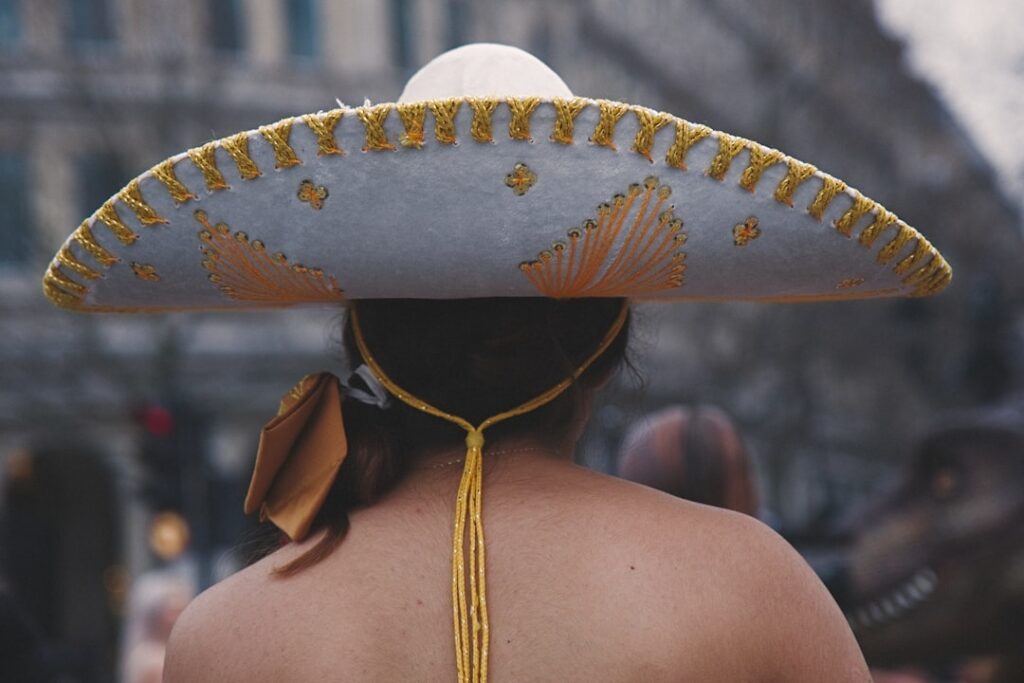The Mexico hat, also known as the sombrero, has a rich and storied history that is deeply intertwined with Mexican culture. Its origins can be traced back to the indigenous people of Mesoamerica, who used wide-brimmed hats made from woven plant fibers to protect themselves from the harsh sun. These early versions of the sombrero were practical and functional, providing much-needed shade and protection from the elements.
As Spanish conquistadors arrived in the region in the 16th century, they brought with them their own hat styles, which were eventually combined with the indigenous designs to create the iconic sombrero that we know today. The sombrero evolved to feature a wide brim, a high, conical crown, and a chin strap to keep it secure in windy conditions. This distinctive design not only provided protection from the sun but also became a symbol of Mexican identity and pride.
The sombrero quickly became an integral part of Mexican culture, worn by both men and women as a practical accessory for outdoor work and leisure activities. Its popularity spread throughout the country, and it became a symbol of Mexican identity and tradition. Today, the sombrero is not only a functional piece of headwear but also a powerful symbol of Mexican heritage and pride.
Key Takeaways
- The Mexico Hat has deep roots in Mexican culture, with origins tracing back to indigenous traditions and customs.
- From its practical use in shielding from the sun to a fashion statement, the Mexico Hat has evolved over time.
- The Mexico Hat holds significant symbolism in Mexican tradition and history, representing identity and heritage.
- Different regions in Mexico have their own unique styles and variations of the Mexico Hat, influenced by local customs and traditions.
- In modern times, the Mexico Hat continues to play a prominent role in Mexican festivals and celebrations, showcasing its cultural significance.
The Evolution of the Mexico Hat: From Practicality to Fashion Statement
Over time, the Mexico hat evolved from being purely practical to becoming a fashion statement and a symbol of national pride. As Mexico underwent social and cultural changes, the sombrero adapted to reflect these shifts. The traditional sombrero was often made from straw or felt and featured intricate designs and patterns that varied by region. These hats were often embellished with colorful ribbons, embroidery, and other decorative elements, making them not only functional but also visually striking.
In the 20th century, the Mexico hat began to be associated with Mexican ranch culture and became a symbol of the country’s rural heritage. It was often worn by charros, or Mexican cowboys, as part of their traditional attire. The sombrero also became popular among musicians and performers, particularly in the genre of mariachi music, where it became an iconic symbol of the genre.
As Mexico’s tourism industry grew, the sombrero became a popular souvenir for visitors to the country, further cementing its status as a symbol of Mexican culture. Today, the Mexico hat has transcended its origins as a practical piece of headwear and has become a fashion statement, with modern variations featuring different materials, colors, and designs. It is often worn during traditional Mexican celebrations and festivals, as well as in everyday life as a symbol of national pride.
The Symbolism of the Mexico Hat: Its Significance in Mexican Tradition and History
The Mexico hat holds deep cultural and historical significance in Mexican tradition. It is not just a piece of headwear but a symbol of national identity and pride. The sombrero is often associated with Mexican fiestas, where it is worn as part of traditional attire during celebrations such as Cinco de Mayo and Dia de los Muertos. Its distinctive design and vibrant colors make it a powerful symbol of Mexican culture and heritage.
In addition to its role in celebrations, the Mexico hat is also associated with Mexican history and tradition. It is often worn during traditional dances and performances, where it becomes a visual representation of Mexican folklore and storytelling. The sombrero is also closely linked to Mexican ranch culture, where it is worn by charros as part of their traditional attire. This association with rural life further reinforces the sombrero’s status as a symbol of Mexican heritage.
The symbolism of the Mexico hat extends beyond its visual appearance. It represents resilience, strength, and pride, qualities that are deeply ingrained in Mexican culture. The sombrero is not just a piece of clothing but a powerful symbol that embodies the spirit of Mexico and its people.
The Different Styles and Variations of the Mexico Hat: Regional Differences and Influences
| Style | Region | Influences |
|---|---|---|
| Sombrero de Charro | Jalisco | Spanish and indigenous influences |
| Sombrero de Jipijapa | Yucatan | Mayan and Spanish influences |
| Sombrero de Tres Picos | Veracruz | Spanish and Afro-Mexican influences |
| Sombrero Ranchero | Northern Mexico | Cowboy and American influences |
The Mexico hat comes in a variety of styles and variations that are influenced by regional differences and cultural influences. In different parts of Mexico, you will find unique variations of the sombrero that reflect the local traditions and customs of each region. For example, in Jalisco, home to the famous mariachi music tradition, you will find sombreros with intricate embroidery and vibrant colors that are worn by mariachi musicians during performances.
In northern Mexico, where ranching is a prominent part of the culture, you will find sombreros that are more practical in design, with wide brims and sturdy construction to provide protection from the sun and wind. These hats are often worn by charros during equestrian events and rodeos, where they are an essential part of traditional attire.
The materials used to make the Mexico hat also vary by region. In some areas, straw is the preferred material for making sombreros, while in others, felt or leather may be used. Each material has its own unique properties and characteristics that make it well-suited for different environments and purposes.
These regional differences and influences have contributed to the diverse range of styles and variations of the Mexico hat that can be found throughout the country. Each variation tells a story about the local culture and traditions, making the sombrero not just a piece of headwear but a reflection of Mexico’s rich cultural diversity.
The Mexico Hat in Modern Times: Its Role in Mexican Festivals and Celebrations
In modern times, the Mexico hat continues to play a significant role in Mexican festivals and celebrations. It is often worn as part of traditional attire during cultural events such as Dia de los Muertos, where it becomes a symbol of remembrance and celebration of loved ones who have passed away. The sombrero is also a common sight during Cinco de Mayo festivities, where it is worn by dancers and performers as part of traditional dances and performances.
The Mexico hat is also an important part of religious festivals and processions in Mexico. It is often worn by participants as they take part in parades and other religious ceremonies, where it becomes a visual representation of faith and tradition.
In addition to its role in formal celebrations, the Mexico hat is also worn in everyday life as a symbol of national pride. It is often seen at outdoor markets, where vendors wear sombreros as they sell their goods, adding to the vibrant atmosphere of these bustling spaces.
The Mexico hat’s enduring presence in modern Mexican culture is a testament to its significance as a symbol of tradition and heritage. It continues to be an important part of Mexican life, worn with pride during both formal celebrations and everyday activities.
The Mexico Hat in Popular Culture: Its Representation in Art, Film, and Literature

The Mexico hat has been represented in various forms of popular culture, including art, film, and literature. In visual art, the sombrero is often depicted as a symbol of Mexican identity and tradition. It has been featured in paintings, murals, and other forms of visual art as a powerful representation of Mexican culture.
In film, the Mexico hat has been portrayed in various ways, often as part of traditional attire worn by characters in movies set in Mexico or featuring Mexican culture. It has become an iconic symbol that is instantly recognizable to audiences around the world.
Literature has also played a role in representing the Mexico hat as a symbol of Mexican culture. In works of fiction and poetry, the sombrero is often used as a metaphor for national identity and pride, reflecting its significance in Mexican tradition and history.
The representation of the Mexico hat in popular culture has helped to elevate its status as a symbol of Mexican heritage. It has become an enduring image that is closely associated with Mexico and its rich cultural traditions.
Preserving the Legacy of the Mexico Hat: Efforts to Protect and Promote its Cultural Importance
Efforts are underway to protect and promote the cultural importance of the Mexico hat and ensure that its legacy endures for future generations. Organizations dedicated to preserving Mexican heritage are working to document the history and significance of the sombrero, ensuring that its cultural importance is recognized and celebrated.
In addition to these efforts, there are initiatives aimed at promoting traditional craftsmanship and supporting artisans who make Mexico hats using traditional methods. By supporting these artisans, these initiatives help to ensure that traditional hat-making techniques are preserved for future generations.
Educational programs are also being developed to raise awareness about the cultural significance of the Mexico hat among younger generations. By teaching children about the history and symbolism of the sombrero, these programs help to ensure that its legacy continues to be valued and celebrated.
Through these efforts, the legacy of the Mexico hat is being preserved for future generations, ensuring that its cultural importance remains recognized and celebrated for years to come.
In conclusion, the Mexico hat holds deep cultural significance in Mexican tradition and history. Its origins can be traced back to indigenous Mesoamerican cultures and have evolved over time to become an iconic symbol of Mexican identity and pride. The different styles and variations of the sombrero reflect regional differences and influences, each telling a unique story about local traditions and customs. In modern times, the Mexico hat continues to play an important role in Mexican festivals and celebrations, as well as in everyday life as a symbol of national pride. Its representation in popular culture has helped to elevate its status as a powerful symbol of Mexican heritage. Efforts are underway to protect and promote its cultural importance, ensuring that its legacy endures for future generations.
Sure, here’s a paragraph that mentions a related article to Mexico hat and includes a link to the related article:
“Looking for more information on Mexican culture and traditions? Check out this fascinating article on Talk Literacy about the history and significance of traditional Mexican hats, including the iconic Mexico hat. Discover the cultural importance and symbolism behind these unique headpieces and gain a deeper understanding of Mexican heritage. Learn more about Mexican hats here.”
FAQs
What is a Mexico hat?
A Mexico hat, also known as a sombrero, is a type of wide-brimmed hat commonly worn in Mexico and other Latin American countries. It is often associated with Mexican culture and is traditionally made of straw or felt.
What is the significance of the Mexico hat?
The Mexico hat holds cultural significance in Mexican and Latin American traditions. It is often worn during festive occasions such as Cinco de Mayo, Day of the Dead, and other celebrations.
What are the characteristics of a Mexico hat?
A Mexico hat typically features a wide brim that provides shade from the sun, a high, conical crown, and decorative elements such as embroidery, colorful patterns, and tassels.
How is a Mexico hat different from other hats?
The Mexico hat is distinct from other hats due to its wide brim and conical shape, which sets it apart from more common hat styles such as fedoras, baseball caps, and beanies.
Is the Mexico hat only worn in Mexico?
While the Mexico hat is closely associated with Mexican culture, it is also worn in other Latin American countries and has become a symbol of Latin American heritage and identity.








